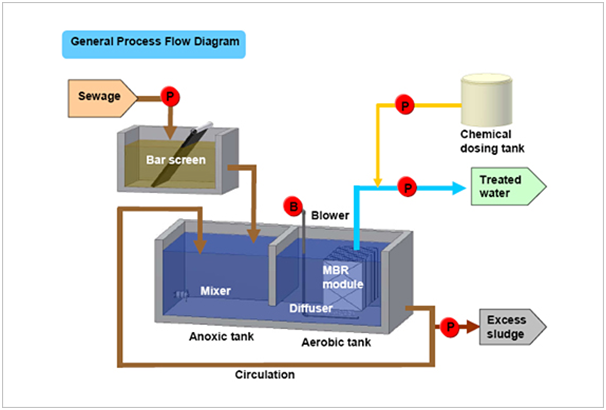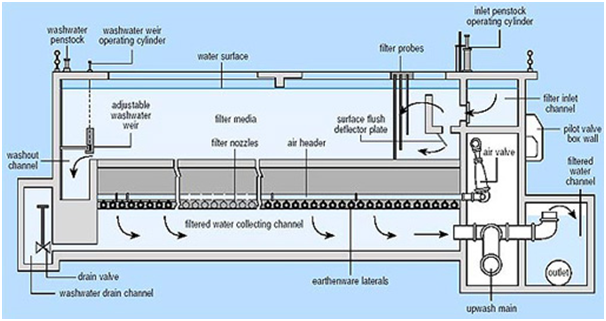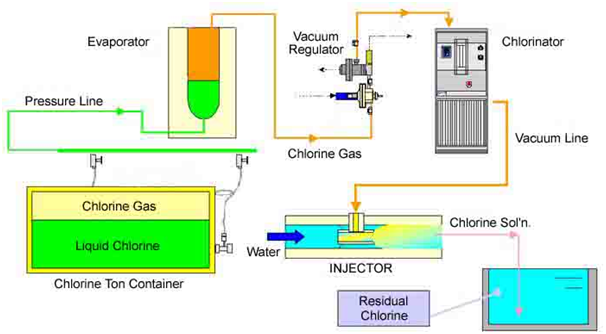Wastewater Treatment Processes
Wastewater Treatment Processes
SEQUENCING BATCH REACTOR (SBR) TREATMENT PROCESS
The sequencing batch reactor (SBR) is a fill-and draw activated sludge system for wastewater treatment. In this system, wastewater is added to a single “batch” reactor, treated to remove undesirable components. Equalization, aeration, and clarification can all be achieved using a single batch reactor. To optimize the performance of the system, two or more batch reactors are used in a predetermined sequence of operations. The operation of an SBR is based on the fill-anddraw principle, which consists of five basic steps: Idle, Fill, React, Settle, and Draw. More than one operating strategy is possible during most of these steps. SBR process can be automated and have been successfully used to treat both municipal and industrial wastewater. In addition to treating domestic sewage, they can also be used for nutrient (N and P) reduction contained in the wastewater. They are uniquely suited for wastewater treatment applications characterized by low or intermittent flow conditions. Operating flexibility and control, minimal footprint and capital cost savings by eliminating clarifiers and other equipment are some of the advantages associated with SBR technology.
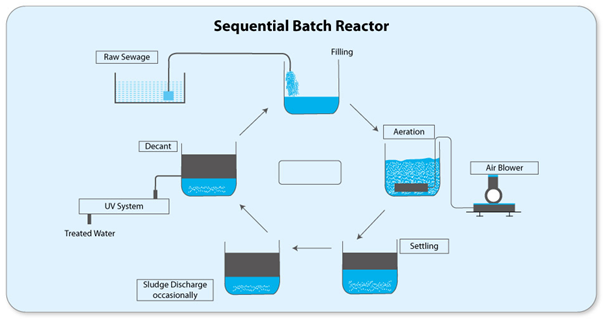
MEMBRANE BIO REACTOR (MBR) TREATMENT PROCESS
The Membrane Bio Reactor (MBR) process is an emerging advanced wastewater treatment technology that has been successfully applied at an ever increasing number of locations around the world including at BWSSB. The MBR process involves a suspended growth activated sludge system that utilises microporous (microns) membranes for solid/liquid separation in lieu of secondary clarifiers. The membranes are made from either organic polymers or ceramic materials. This very compact arrangement produces veryhigh quality effluent water suitable for reuse applications. In addition, it provides a barrier to certain chlorine resistant pathogens such as Cryptosporidium and Giardia. The advantages of MBR include elimination of secondary clarifiers and tertiary filtration processes, thereby reducing plant footprint.
ACTIVATED SLUDGE PROCESS (ASP)
The Activated Sludge Process (ASP) is one of legacy biological wastewater treatment alternatives in Secondary Treatment. When Activated Sludge is added to wastewater, the organisms in this mixed liquor quickly decompose the wastes in the wastewater being treated. After a required period of aeration and agitation in the aeration tank, the mixed liquor usually flows to a separate tank called a secondary clarifier where the activated sludge is allowed to settle out and the remaining liquid is discharged as effluent. The settled sludge is either disposed of as waste activated sludge or reused in the aeration tank as return activated sludge. Some sludge must always be returned to the aeration tanks to maintain an adequate population of organisms.
For the activated sludge process to work properly, one must control the number of organisms and the dissolved oxygen level in the aeration tank, and the treatment time in the aeration tank.
POWER GENERATION
Wastewater treatment plants use a lot of energy for operation and create greenhouse gas emissions. They also have the potential to be sources of renewable energy. The wastewater treatment plants use anaerobic digestion to generate heat and electricity on site. During anaerobic digestion, specific microorganisms under controlled environment breakdown organic materials.The methane gas produced from this process is then used to generate heat and electricity. This energy can be utilized within the treatment plant for operational needs. This substantially reduces operating costs of the sewage treatment plant. If excess energy is still available, it can be sold to local electrical companies and generate revenue.
EXTENDED AERATION PROCESS
Extended aeration activated sludge plants have fulfilled the need for high efficiency treatment of small volume wastes of both domestic and industrial origin. These plants are normally without primary sedimentation tanks and employ an extended aeration period for the purpose of aerobically oxidizing organic matter. In the extended aeration process about 98% or more of the organic materials added is removed and converted either to carbon dioxide and water or new biological solids. The active biological solids utilize oxygen while undergoing endogenous decay to oxidize the degradable portion of their cells to carbon dioxide and water with a resulting decrease in cell mass. This process could continue until the resulting sludge mass is an inert material.
UPFLOW ANAEROBIC SLUDGE BLANKET (UASB) PROCESS
UASB uses an anaerobic process whilst forming a blanket of granular sludge which suspends in the tank. Wastewater flows upwards through the blanket and is processed (degraded) by the anaerobic microorganisms. The upward flow combined with the settling action of gravity suspends the blanket with the aid of flocculants. The blanket begins to reach maturity at around three months. Small sludge granules begin to form whose surface area is covered in aggregations of bacteria. In the absence of any support matrix, the flow conditions create a selective environment in which only those microorganisms capable of attaching to each other survive and proliferate. Eventually the aggregates form into dense compact biofilms referred to as "granules".
Biogas with a high concentration of methane is produced as a by-product, and this may be captured and used as an energy source, to generate electricity for export and to cover its own running power. The technology needs constant monitoring when put into use to ensure that the sludge blanket is maintained, and not washed out (thereby losing the effect).
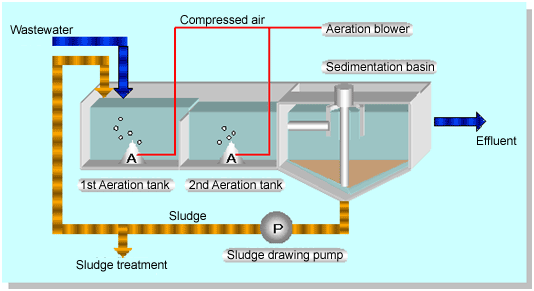
TRICKLING FILTER TREATMENT
Trickling filters (TFs) are used to remove organicmatter from wastewater. The TF is an aerobictreatment system that utilizes microorganismsattached to a medium to remove organic matterfrom wastewater. These systems are known asattached-growth processes. In contrast, systems in which microorganisms are sustained in a liquid areknown as suspended-growth processes. TFs enable organic material in the wastewater to beadsorbed by a population of microorganisms(aerobic, anaerobic, and facultative bacteria; fungi;algae; and protozoa) attached to the medium as abiological film or slime layer (approximately 0.1 to0.2 mm thick). As the wastewater flows over themedium, microorganisms already in the watergradually attach themselves to the rock, slag, orplastic surface and form a film. The organicmaterial is then degraded by the aerobicmicroorganisms in the outer part of the slime layer.
PLATE SETTLERS
Plate settlers are used for enhanced settling of particles. It is normally a compact inclined plate type clarifier. Clarification of wastewater having suspended solids and colloidal particles can be clarified using plate settlers.Settling capacity is increased by the use of the plate settlers. Stacks of parallel rectangular or flat pieces separated by a few inches and sloping vertical in the direction of flow are used in order to increase the efficiency of settlers.It is most commonly used in a rectangular clarifier reducing the vertical distance a suspended particle must travel.Hoppers are kept at the bottom of the clarifier to collect the solid particles which are settling down and the clarified liquid exits.At the bottom of the hoppers, sludge is drawn off and the liquid exits the unit at the top of the weir.
FILTRATION
Filtration is a process that removes particles from suspension in water. Filtration is normally used as a final polishing step and usually referred to as tertiary treatment. Removal takes place by a number of mechanisms that include straining, flocculation, sedimentation and surface capture. Filters consist of a medium within which it is intended most of the particles in the water will be captured. Granular media filters are used in either of two distinct ways which are commonly called slow-sand filtration and rapid gravity or pressure filtration. Sand is the primary filter medium commonly used in mono media filtration. Dual media filtration process employs more than one medium (e.g., sand and anthracite). When the filters are used as the final means of particle removal from the water/wastewater, then the filters may need to be preceded by another stage of solid-liquid separation (clarification) such as sedimentation.
UV Treatment
Ultraviolet (UV) treatment is used to kill/inactivate harmful microorganisms found in the treated effluent. It is normally used as the final treatment process prior to discharge. UV treatment is a physical process where a germicidal UV radiation (200-300 nm)alters the DNA of microorganisms thus losing their ability to reproduce and infect human beings. The UV technology depends on the type of UV lamp used, i.e. low pressure high output (LPHO) or medium pressure (MP). UV is not known to produce any harmful by products like chlorination process.
CHLORINATION
Chlorination treatment is a disinfection process used to kill harmful microorganisms found in the treated sewage effluent. Regulations normally call for disinfection of indicator as well as harmful microorganisms within the acceptable limits. Appropriate chlorine dose and contact time with the effluent in needed for chlorination to be effective. Chlorine can be applied either in gaseous or liquid forms. Dechlorination may be required if excess chlorine is applied because residual chlorine is harmful to aquatic life. Unlike UV, chlorine produces disinfection by products which are suspected carcinogens.
SOIL BIOTECHNOLOGY
Soil Biotechnology (SBT) is an environment friendly waste processing technology that offers systems for processing of both solid organic wastes and wastewater treatment using bacteria, earthworms and mineral additives in a garden-like setup. This technology was initially developed at Indian Institute of Technology (IIT), Mumbai over two decades of research. It reinforces the carbon and nitrogen cycles in nature. Purification takes place by adsorption, filtration and biological reaction. The process operates in aerobic mode; thus eliminating possibility of foul odor. The wastewater processing area is thus developed into a green belt, which easily integrates into any existing landscape.

